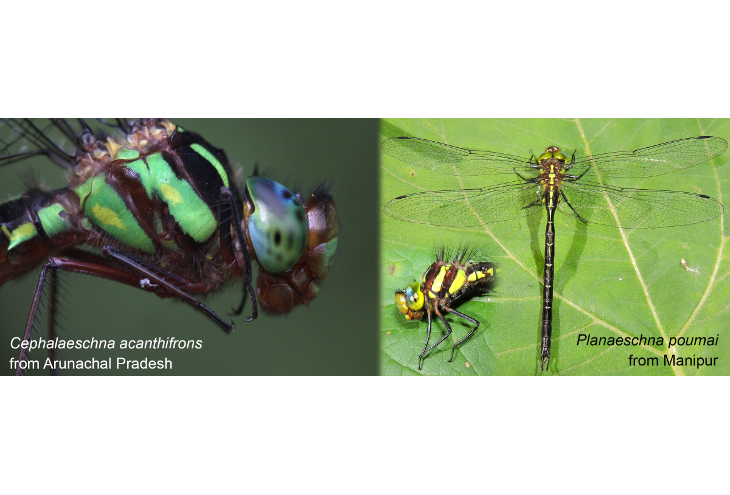The Himalaya and north-eastern India are very important biodiversity hotspots in the world. They are also relatively less explored in recent times, although new research efforts are intensifying in documenting biodiversity in this region. These efforts are paying big dividends, with many species that are new to science being discovered in these remote parts. The latest discovery of two new dragonfly species, named Cephalaeschna acanthifrons and Planaeschna poumai, was announced today by Mr. G. N. Sinha (IFS, Principal Chief Conservator of Forest (Wildlife)), Department of Environment and Forests, Government of Arunachal Pradesh. “These new species discoveries are valuable in documenting the remarkable insect fauna of the north-eastern states. This also provides critical information that helps the forest department protect and manage the state’s exceptional biodiversity”, remarked Mr. Sinha.
The new dragonfly species belong to the group called Darners (Family Aeshnidae, subfamily Brachytroninae). They are shy insects, which usually fly above 8-10 feet from the ground. They are active only during July-October, the rainy season when not many scientists visit the remote parts of north-eastern India. “Both these factors make it difficult to study these dragonflies. No species of this subfamily had been reported from India in the past three decades, so it is exciting to be able to make these discoveries”, explained Mr. Shantanu Joshi, a young research student from the National Centre for Biological Sciences (TIFR, Bengaluru), who described these species along with his guide Dr. Krushnamegh Kunte in a research paper in the journal Zootaxa. Cephalaeschna acanthifrons was discovered in the Eaglenest Wildlife Sanctuary, Arunachal Pradesh, where several new species have recently been found. Dr. Kunte’s research lab at NCBS has undertaken a long-term insect survey at Eaglenest WLS. This survey and other research efforts are strongly supported by the Arunachal forest department along with the Bugun Welfare Society and other local conservation groups. All of them together try to protect species-rich forests inside the wildlife sanctuary as well as on the surrounding community lands, where many of the recently discovered new species have been found.
Planaeschna poumai was discovered in and around the community forests of the Senapati District, Manipur, where Mr. Joshi was surveying dragonflies with the Veino family from Dimapur. The Veino family has also recently discovered several insect species that had previously not been known from India. Their butterfly and dragonfly surveys are particularly useful for understanding the natural history of Nagaland and Manipur states in north-eastern India. Planaeschna poumai, which is endemic to these forests based on our very limited current knowledge, is named after the Poumai tribe of Manipur on whose community lands this species was discovered. The Joshi-Veino field team also discovered two more dragonfly species (Burmagomphus divaricatus and Pseudothemis zonata) in north-eastern India for the first time, as reported in another recent research paper in the Journal of Threatened Taxa.
“These are exciting times to be a naturalist and a scientist in India”, said Dr. Kunte. The recent surge in taxonomic studies and species discoveries of Indian dragonflies and damselflies (together called ‘odonates’) has made these insects very popular among the general public. A new website called Odonata of India (http://www.indianodonata.org), where ordinary citizens contribute to scientific datasets, is also fueling intense public interest in these fascinating insects. “The collaboration and cooperation between the local communities, general public, scientists and the state forest department is proving to be extremely helpful not only in species discoveries but also in nature conservation in the Eaglenest landscape”, said Mr. Millo Tasser, the Divisional Forest Officer and the chief wildlife officer of Eaglenest WLS, adding, “All these species discoveries make this sanctuary very special.”
Citation of the paper in which the new dragonfly species were described:
Joshi, S., and K. Kunte. 2017. Two new dragonfly species (Odonata: Anisoptera: Aeshnidae) from north-eastern India. Zootaxa, 4300(2):259–268.
Image copyright: Cephalaeschna acanthifrons: Subhajit Mazumder; Planaeschna poumai: Joyce Veino and Shantanu Joshi, used with permission.










0 Comments